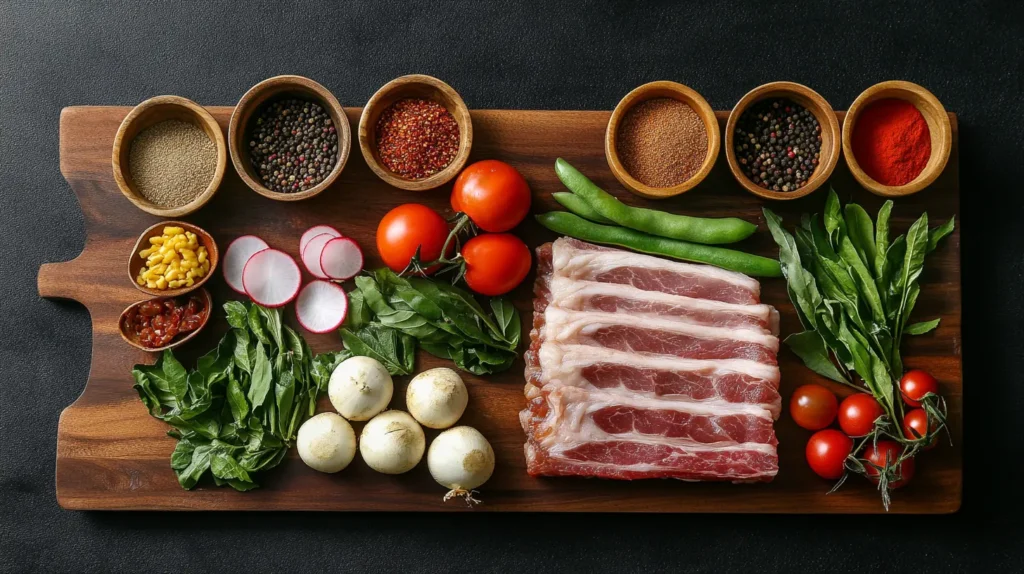Introduction
Sinigang is a beloved Filipino soup known for its distinctly tangy and savory flavor, a dish that perfectly represents the essence of Filipino cuisine. Traditionally sour and hearty, Sinigang is more than just a meal—it’s an expression of Filipino culture and a reminder of home for many. Its unique combination of tamarind as a souring agent, fresh vegetables, and tender meat creates a comforting dish that’s both satisfying and nutritious.
In Filipino households, Sinigang is often enjoyed during gatherings, rainy days, or simply as a staple in everyday meals. Its versatility allows for endless adaptations, making it accessible to cooks of all skill levels. Whether it’s pork, shrimp, or fish, each version of Sinigang brings its own charm to the table.
In this article, we’ll walk you through everything you need to know to create the perfect Sinigang, from sourcing ingredients to cooking tips that ensure a flawless result. By the end, you’ll feel confident making this iconic dish for family and friends.
Ingredients Needed for Sinigang Recipe

Creating an authentic Sinigang begins with carefully selected ingredients that bring out its signature sour and savory flavors. Here’s a detailed breakdown of what you need to prepare this classic Filipino dish.
Essential Ingredients for an Authentic Sinigang Recipe
- Meat or Seafood:
- Pork: Pork belly (liempo) or ribs (butu-butu) are commonly used for their tenderness and flavor.
- Shrimp (Hipon): Fresh shrimp adds a light, briny taste to the broth.
- Fish: Milkfish (bangus) or any white fish provides a milder alternative.
- Chicken: Although less traditional, chicken can be used for a lighter version.
- Souring Agent:
- Tamarind (Sampalok): Fresh tamarind is the most traditional choice, but tamarind paste or powder is convenient and widely available.
- Alternatives: Calamansi, kamias (bilimbi), or green mango can be used for a unique twist. Pre-packaged Sinigang mix is also a practical option.
- Vegetables:
- Kangkong (Water Spinach): Adds freshness and a hint of bitterness.
- Sitaw (String Beans): Provides texture and absorbs the broth’s flavor.
- Radish (Labanos): Offers a mild, peppery crunch.
- Eggplant (Talong): Adds a creamy element.
- Okra: Thickens the broth naturally.
- Tomatoes and Onions: Form the base of the broth’s flavor.
- Seasoning:
- Fish sauce (patis) for saltiness and depth.
- Salt and pepper to taste.
- Rice:
- Sinigang is best served with steamed white rice to balance the sour and savory notes.
Variations in Ingredients for Sinigang Recipe
- Vegetarian Sinigang: Replace meat or seafood with tofu or mushrooms for a plant-based version.
- Seasonal Substitutions: Add vegetables like bok choy, pechay (Chinese cabbage), or even green beans depending on availability.
Where to Source Fresh Ingredients for Sinigang Recipe
- Local Markets: Fresh tamarind, kangkong, and other native ingredients are commonly available at Filipino or Asian markets.
- Supermarkets: Pre-packaged Sinigang mix and frozen alternatives for hard-to-find items make it easier to prepare Sinigang outside the Philippines.
- Online Stores: Many specialty Filipino grocery stores offer delivery for items like tamarind paste or fish sauce.
Step-by-Step Sinigang Recipe Preparation
Cooking Sinigang is an enjoyable process that combines simple techniques with bold flavors.
Preparing Ingredients for Sinigang Recipe
- Meat or Seafood:
- If using pork, cut it into bite-sized pieces. Rinse thoroughly to remove impurities.
- For shrimp, clean and devein. Leave the shell on for a richer flavor or peel if preferred.
- For fish, clean and slice into manageable portions.
- Vegetables:
- Wash all vegetables thoroughly under running water.
- Slice the radish, eggplant, and tomatoes into thin, even pieces.
- Trim the string beans into 2-inch sections.
- Separate the leaves of the kangkong from their stems.
- Souring Agent:
- If using fresh tamarind, boil the pods in a small pot of water until soft, then mash to extract the juice. Strain the juice and set aside.
- For tamarind paste or powder, dissolve it in warm water.
Cooking the Broth for Sinigang Recipe
- Start with the Base:
- Heat a large pot over medium heat.
- Add a small amount of oil and sauté sliced onions and tomatoes until softened and fragrant.
- Add the Meat or Seafood:
- For pork: Add the meat to the pot and cook until lightly browned. Pour in enough water to cover the meat and bring to a boil.
- For shrimp or fish: Add these later in the cooking process to prevent overcooking.
- Simmer and Skim:
- Once the water is boiling, reduce to a simmer and skim off any scum that rises to the surface. This ensures a clear broth.
- Add fish sauce for seasoning at this stage.
Adding Vegetables and Souring Agents to Your Sinigang Recipe
- Introduce the Souring Agent:
- Pour in the tamarind juice or dissolved powder. Adjust the amount to achieve the desired level of sourness.
- Taste the broth and add salt or more fish sauce as needed.
- Add Vegetables in Stages:
- Start with harder vegetables like radish and eggplant, as they take longer to cook.
- Follow with string beans and okra.
- Add leafy greens like kangkong at the end, cooking just until wilted.
Serving the Sinigang Recipe
- The key to Sinigang lies in balancing its sour, salty, and savory flavors. Taste the broth frequently and adjust seasoning as needed.
- If using pre-packaged Sinigang mix, follow the instructions for the right amount. You can enhance the flavor with fresh tamarind or calamansi.
Final Touches and Serving
- Cooking Time:
- Pork: Simmer for 45–60 minutes until tender.
- Shrimp: Cook for 3–5 minutes or until they turn pink.
- Fish: Simmer gently for 8–10 minutes to avoid breaking apart.
- Serve Hot:
- Ladle the Sinigang into bowls and serve immediately with steamed white rice.
Cooking Tips and Techniques for Sinigang Recipe

Preparing Sinigang may seem simple, but mastering the dish requires some thoughtful techniques. Here are tips to elevate your Sinigang and adapt it to your preferences.
Tips for First-Time Cooks Making Sinigang Recipe
- Prep Ingredients in Advance:
- Chop and measure all your ingredients before starting. This ensures a smooth cooking process without delays.
- Layer the Flavors:
- Sautéing the onions and tomatoes at the beginning enhances the broth’s depth of flavor.
- Don’t Rush the Broth:
- If using pork or other meats, simmer them slowly. This releases the meat’s natural flavors and results in a tender texture.
Achieving the Perfect Consistency in Your Sinigang Recipe
- Clear vs. Thick Broth:
- For a clear broth, skim off impurities and excess fat during cooking.
- For a thicker broth, cook the tamarind or add mashed vegetables like okra.
- Balance Sourness and Saltiness:
- Too sour? Add a small pinch of sugar or more broth to balance the flavor.
- Too salty? Add a little water or more vegetables to dilute the saltiness.
- Vegetable Texture:
- Avoid overcooking vegetables, especially leafy greens, to preserve their vibrant colors and textures.
Substituting Ingredients in a Sinigang Recipe
- Alternative Proteins:
- Use tofu or seitan for a vegetarian or vegan version.
- Chicken breasts or thighs can replace pork for a lighter dish.
- Souring Agents:
- If tamarind isn’t available, try calamansi, lemon, or even vinegar. Adjust the quantity to taste.
- Seasonal Vegetables:
- Substitute with what’s fresh in your area, like zucchini, spinach, or kale.
Enhancing Flavor
- Roasting Tamarind:
- Roast fresh tamarind pods slightly before boiling them for a deeper, smoky flavor.
- Double Broth Method:
- Use a shrimp or fish stock instead of water for a seafood Sinigang.
- Pork broth enhances the richness of a pork-based Sinigang.
- Spices and Aromatics:
- Add green chilies for a spicy twist.
- Ginger can be included for a hint of warmth, especially in fish Sinigang.
Common Mistakes to Avoid
- Overcooking Meat or Seafood:
- Pork should be tender, not mushy.
- Shrimp or fish can become tough if left in the pot too long.
- Underseasoning:
- Always taste the broth at each stage and adjust seasoning gradually.
- Skipping Fresh Ingredients:
- Whenever possible, use fresh tamarind and vegetables for the best flavor. Pre-packaged mixes are convenient but lack the depth of fresh components.
By following these tips, you’ll be able to prepare Sinigang like a pro, creating a dish that’s flavorful, balanced, and unforgettable.
Health Benefits of Sinigang Recipe
Sinigang is not only a flavorful comfort food but also a dish brimming with health benefits. Its rich assortment of fresh vegetables, lean proteins, and natural souring agents makes it a nutritious meal that can easily be adapted for different dietary needs.
Nutritional Benefits of Sinigang Recipe Ingredients
- Fresh Vegetables:
- Kangkong (Water Spinach): Packed with iron, vitamins A and C, and fiber, it promotes healthy digestion and supports the immune system.
- Radish (Labanos): A good source of antioxidants and minerals, radish aids in detoxifying the body and improving skin health.
- Eggplant: High in dietary fiber and low in calories, eggplant supports heart health and helps manage weight.
- String Beans (Sitaw): Rich in vitamin C and potassium, these beans boost immunity and help regulate blood pressure.
- Tomatoes: A natural source of lycopene, tomatoes contribute to heart health and protect against certain cancers.
- Protein Sources:
- Pork: Provides high-quality protein and essential vitamins like B6 and B12, which aid in muscle repair and energy production.
- Shrimp: Low in calories and high in protein, shrimp also contains omega-3 fatty acids for brain and heart health.
- Fish: Offers lean protein and is an excellent source of omega-3s, calcium, and vitamin D.
- Souring Agents:
- Tamarind: Contains magnesium, potassium, and antioxidants that support heart health and reduce inflammation.
Why Sinigang Recipe Is a Healthy Comfort Food
- Low in Calories:
- Sinigang is naturally low in calories, making it a guilt-free choice for those watching their weight.
- By using lean protein and limiting added fats, you can further reduce its calorie content.
- Rich in Hydration:
- The soup’s broth provides electrolytes and fluids, helping to keep you hydrated.
- Boosts Immunity:
- The combination of vegetables, tamarind, and spices delivers a variety of vitamins and minerals that strengthen the immune system.
Lower-Calorie Versions of Sinigang Recipe
- Vegetarian or Vegan Sinigang:
- Substitute meat with tofu, mushrooms, or plant-based protein alternatives. Use vegetable broth instead of meat-based stock.
- Limit the Fat Content:
- Trim visible fat from pork or opt for leaner cuts of meat like pork tenderloin.
- Reduce or omit the use of cooking oil during sautéing.
- Enhance with Superfoods:
- Add kale, spinach, or moringa leaves for an extra boost of nutrients.
Long-Term Health Benefits
- Digestive Health:
- The high fiber content in vegetables and tamarind aids in digestion and prevents constipation.
- Heart Health:
- Using fish or seafood in Sinigang provides omega-3 fatty acids, which lower bad cholesterol and reduce the risk of heart disease.
- Weight Management:
- The soup’s combination of proteins and vegetables keeps you feeling full, reducing the likelihood of overeating.
FAQs
What makes Sinigang unique from other sour soups?
Sinigang stands out because of its tangy and savory flavor, primarily derived from tamarind. Unlike other sour soups, it incorporates a variety of fresh vegetables and proteins, making it a hearty and versatile dish. Its balance of sourness, saltiness, and umami flavors sets it apart from similar dishes found in other cuisines.
Can Sinigang be made vegetarian?
Yes, Sinigang can easily be made vegetarian. Substitute the meat or seafood with tofu, mushrooms, or plant-based protein alternatives. Use a vegetable-based broth and add tamarind or a Sinigang mix for the sour flavor. Including more vegetables like bok choy or kale adds both nutrition and flavor.
How do you store and reheat leftovers?
To store Sinigang, transfer it to an airtight container and refrigerate for up to 3 days. To reheat, pour the soup into a pot and warm it over medium heat, stirring occasionally. If reheating in a microwave, use a microwave-safe bowl and heat in intervals, stirring between each to ensure even heating.
Is it better to use fresh or packet-based souring agents?
Using fresh tamarind provides a more natural and robust flavor, making it the preferred option. However, packet-based souring agents, such as pre-packaged Sinigang mix, are convenient and deliver consistent results. Combining both can enhance the dish, giving it the depth of fresh ingredients and the convenience of ready-made mixes.
What side dishes pair well with Sinigang?
Sinigang is typically served with steamed white rice, which balances the soup’s bold flavors. Side dishes such as grilled or fried fish, salted eggs, or a simple salad complement the tangy soup beautifully. Adding a small serving of fried dried fish (tuyo) or crispy pork belly (lechon kawali) enhances the meal’s texture and flavor.
How long does Sinigang take to cook?
The cooking time depends on the protein used:
- Pork: 45–60 minutes for tenderness.
- Fish or shrimp: 10–15 minutes, as these cook quickly.
- Vegetarian Sinigang: 20–30 minutes, as the focus is on simmering the vegetables.
Preparation time for chopping and cleaning ingredients should also be factored in, taking about 15–20 minutes.
Conclusion
Sinigang is not just a dish—it’s an expression of Filipino culture, bringing families together over a warm and hearty meal. Its perfect balance of sourness and savory goodness makes it a timeless favorite. Whether you’re a seasoned cook or trying it for the first time, this Sinigang recipe is sure to satisfy.
For more delicious Filipino recipes and cooking inspiration, visit the Sinigang Recipe collection on TonsRecipes.com and explore other comforting dishes like Quick Dinner Ideas for Two and BBQ Shrimp Recipe. These recipes will surely make your meals more exciting and flavorful!

